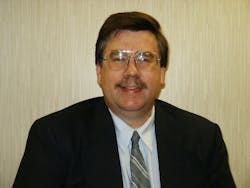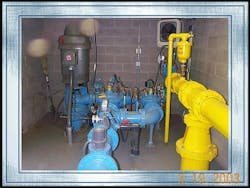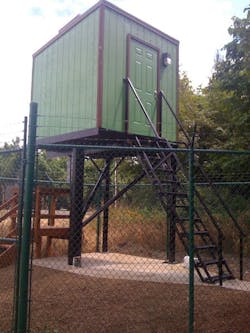Industry Icon: Teamwork, Integrity & Ethics
Bob Crossen is senior managing editor for WWD. Crossen can be reached at [email protected].
Just an ordinary man from Oregon who values integrity and ethics. That is how Ed Butts describes himself. For more than 40 years, Butts has paved his own path as a professional engineer that has been influenced by his peers, basketball and even a move to Anchorage, Alaska.
He has been a lifetime member of the American Public Works Association. He is a member of the American Water Works Association and the National Ground Water Association. He is a former vice president, president-elect and state president for the Professional Engineers of Oregon, and a fellow of the American Society of Civil Engineers of which he has been a member for 27 years. He has also been on numerous committees across many organizations.
For Butts, involvement in these organizations helped to build his business connections, but more importantly, they established his reputation and credibility, two characteristics critical to his engineering background.
Butts is self-taught. He studied engineering books at the kitchen table, soaked up knowledge from colleagues and peers at job sites and conferences, and used his personal and professional drive to pass the Oregon Professional Engineering Exam — which does not require a degree.
Perhaps most interesting to this story is that if it were not for the game of basketball, the catalyst to spark that drive may have never occurred.
How Basketball & Engineering Relate
Butts grew up in Albany, Oregon, with his mother. His father lived in Salem, Oregon, where he owned and operated Valley Well Drillers, a well drilling and pump company.
Throughout his early childhood years, Butts — like most young boys — was obsessed with sports, particularly basketball and football.
“I like the teamwork aspect of [basketball] more than football,” Butts said, adding he is more than 6 feet tall. “I just looked at football as a way to get in shape for basketball.”
Unlike football, which has a lot of stopping and starting, basketball was more enjoyable to him. A play in football, he said, often results in man-on-man coverage, as if the game were 11 separate one-on-one duels on the field for each play. Basketball on the other hand was more dynamic. Players created screens and picks to set each other up for easy baskets. While there is a one-on-one element to basketball, each team functioned as a symbiotic unit. Basketball players have an even more interconnected role in overall team success.
This team work, he noted, is not unlike a finished water or wastewater treatment plant. Each piece of equipment is a player working towards the overall goal. Every step of the process has a critical role to play and must work together to achieve the desired outcome. Butts compared this to designing a basketball play with a pick and roll to set up a free man on the court.
“That’s what engineering is. You’re assembling components and parts to make a whole product, and that’s really how a basketball play works,” Butts said. “You’re using each person on the floor to hopefully score a basket and then in the end win the game.”
Career Steps
When he graduated from high school, Butts went to work for his father’s company on the pump side of the business. After only a handful of years, the business collapsed in 1976 after his father suffered a heart attack that left him unable to manage the business. Butts took a job with another firm, Stettler Supply Co., and married his wife JoAnne in 1978. They moved to Anchorage, Alaska, to pursue a change in Butts’ career, but the move was a “disaster.” Long summer days kept him up until 2 or 3 a.m.
Eventually, they returned to Salem and Butts returned to his previous position with Stettler Supply Co., where he remained with the company until 2004. Using business concepts he learned during his time in Alaska, he rose through the ranks of management from field technician to associate engineer, chief engineer, vice president of engineering and eventually president. In his personal life, however, Butts was playing city league basketball as a hobby, and the game made an irreversible change to his career.
“I was playing city league basketball here in Salem and started developing back problems from taking too many hits,” he said. “Eventually, I had to get back surgery and that just totally destroyed my career in mechanical field work.”
After that surgery, Butts wanted to go to school for engineering, but that was complicated by raising a family with a young daughter. The time and financial investment in college was too great. So he hit the books on his own.
“I honestly started sitting at a table and my wife would help me,” Butts said. “And I just started learning engineering through self-study, and in Oregon, if you can pass the test — because it’s a difficult test — if you meet certain criteria of experience and pass the test, you can become a professional engineer.”
In recent years, a greater emphasis has been placed on four-year degrees for that criteria. Butts is one of few professional engineers remaining in the state who has earned his license through self-study and on-site experience without formal college education. He got his first professional license in 1986 in civil engineering.
Building Credibility & Respect
While working at Stettler, Butts was tasked with a new line of business in the municipal market, and his first client was a small town of 20,000 people that had to disconnect from the Salem water system.
“So one of the first projects that I ever worked on was developing a new water system for a small town of 20,000 people, which I had never done before,” Butts said. “I’m still their engineer all these years later. I’ve designed every facility they have. Now they have almost 40,000 people. They’ve become the city of Keizer. I’m proud to say that I’ve been involved in everything that has happened since the late 1970s.”
He said he was “scared to death” because it was so much bigger with much greater stakes than the projects he was used to conducting. While he said he has made mistakes throughout his career — just like any engineer eventually does — he learned from them all and goes the extra mile to prove his worth. This, he said, stems from a deep respect for the profession.
“In some ways, engineers don’t get the same recognition that lawyers and doctors do, but we work just as hard and we have to know our trade just as much as they do,” Butts said. “I’ve always had that chip on my shoulder about the profession. Its image and appearance to the public, and thats one of the main reasons I got involved with the Professional Engineers of Oregon.”
Something to Prove
Throughout his career, engineers who had received collegiate degrees would talk down to him, despite his years of experience and knowledge gained through field work as well as design work. Being involved visibly and prominently in professional associations and organizations established his credibility.
“Coming up the way I did, I always had sort of an inferiority feeling, you know. I didn’t come up the same way everybody else did,” Butts said.
He resented the comments that he could not possibly know what he was doing because he did not have a degree because he put in so much work to study and pass the exam and get his licenses. So he always went the extra mile to prove his worth.
In 2004, he started his own company — 4B Engineering — and now employs his daughter Brooke Shattuck. For more than 40 years, Butts has deigned to prove his work means something, and he has been awarded with the 2021 WWD Industry Icon. A status, he said, feels out of his league.
“It’s very humbling and an honor. I don’t know if I care for the word icon. It’s hard to live up to. It’s right below a deity,” he said. “I look at it more as an incentive to try to do more for my peers and work with them to get the message out that our environment and our infrastructure is really damaged. We’re going to leave a world that our kids and our grand kids are not going to be able to functionally operate in. I’m really concerned about that.”
He said this should be a wake up call to address environmental and infrastructure decisions before it is too late. That, he said, is his first message to send as an icon to his peers.



